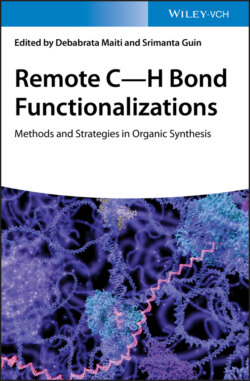Читать книгу Remote C-H Bond Functionalizations - Группа авторов - Страница 25
2.3 Mechanistic Considerations
ОглавлениеThe mechanisms of the aforementioned template assisted meta‐C–H activation reactions are still not exactly very clear at present. However, detailed mechanistic investigations through computational and experimental mechanistic studies have been performed by such as the groups of Houk, Yu, and Wu, and the Maiti group to gain some hints of the reaction mechanism.
The representative template assisted meta‐C–H activation is olefination via Pd(II)/Pd(0) process with the nitrile‐based directing template. Thus, a tentative catalytic cycle could be proposed for this reaction (Scheme 2.65). The catalytic process proceeds through five major steps: C–H activation, olefin binding and alkene migratory insertion, β‐hydride elimination, reductive elimination, and re‐oxidation of the Pd‐catalyst. Computational study using density functional theory elucidated that the C–H activation step, which proceeds via a concerted metalation–deprotonation (CMD) pathway, was the rate‐ and regioselectivity‐determining step [55]. However, unlike the presentation in Scheme 2.65, it was found that the C–H activation with the nitrile‐based directing template occurred via a Pd–Ag heterodimeric transition state (Scheme 2.66). Moreover, the nitrile directing template coordinated with Ag an end‐on fashion rather than the Pd metal center. The Pd was then linked with Ag by the bridging acetate ligand and delivered to the meta‐CH bond in the transition state, resulting in the observed high meta‐selectivity. However, it is worth noting that not all the template assisted meta‐C–H olefination required the use of silver salt, such as the meta‐C–H olefination of benzoic acids by the Li group [28]. In addition, significant effects of distortions of the template were observed in the structural and distortion energy analysis of the transition states, which had help to devise the conformationally flexible directing template for benzoic acids by the groups of Houk and Yu in 2017 [29].
Scheme 2.65 Proposed catalytic cycle for meta‐C–H olefination.
Scheme 2.66 Proposed transition state through computational study.
Subsequently, Houk, Yu, Wu, and coworkers revealed the dual roles of the amino acid ligand in improving reactivity and selectivity through mass spectrometry (MS) and DFT calculations [56]. It was found that the amino acid ligand aced as both a dianionic ligand and a proton acceptor, leading to the stabilization of the monomeric Pd complexes and serving as the internal base for proton abstraction through a CMD pathway.
Besides the MPAA ligand, the HFIP solvent is another key factor for most of the template assisted meta‐C–H activation reactions. Although the exact role of HFIP is unknown at present, Maiti and coworkers proposed that the solvent HFIP could act as a coordinating ligand in the early stage of the reaction to promote the reaction through experimental and computational investigation [40,54]. Moreover, they also found that the hydrogen‐bonding between HFIP and the pyrimidine‐based template was vital to decrease the basicity of the pyrimidine group and increase the π‐acidity of the Pd center based on nuclear magnetic resonance (NMR) studies [51].
